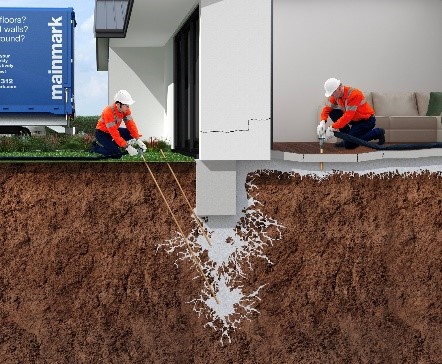
Angelina Varchione, Technical Sales Engineer at Mainmark
When identifying the cause, seriousness and possible solutions of cracks in a home – the type, size and location is critical. So, if you’re a homeowner or prospective buyer – at what point should you begin to worry?
The discovery of cracks in walls or ceilings often puts off prospective buyers from purchasing a house, while new and existing homeowners could be unsettled to find these upon moving in or developing over the course of time.
Although solid, stable foundations help ensure your home has the support it needs for years to come, buildings can and do move – so not every crack is cause for concern.
When should you worry about cracking?
Small, hairline cracks are common and not usually concerning. However, you should closely monitor cracks that start at windows, doorways or corners of buildings, especially larger ones, as these can indicate that the property’s foundation have shrunk or lost strength (called subsidence). Additionally, if cracks suddenly appear, they can be an indication of deeper, structural issues.
Every home is different. Serious cracking and subsidence aren’t always obvious, and if you’re a prospective buyer, you may not be able to monitor cracks over time. That’s why it’s important to know what to look for.
What signs should you watch out for?
Problematic cracks typically start at windows, doorways or corners of buildings, are often zig-zag/stepped cracks in brickwork, usually follow the mortar lines and are big enough to insert your little finger into (about half a centimetre/5mm). It is also recommended that you look out for other warning signs which can also indicate subsidence.
The main signs of subsidence include:
- sinking/slopping floors
- cracks in walls, paths and driveways
- windows and doors become misaligned or jammed
- skirting boards separating from the wall
- formation of puddles around the perimeter of a home
Depending on the underlying cause, you may need a plumber to address leaking pipes, or deeper investigations by other experts to determine the reason for structural issues.
What to do if your home is subsiding
However, these signs don’t always mean the end of the road. If you find a home has any of these signs – or if you feel the cracks are worsening – structural, geotechnical or ground engineering experts can help.
After calling an expert, you’ll need to consider the options available. The best long-term solution for fixing large cracks is to raise, re-level and re-support the building.
The most traditional form of level correction is concrete underpinning, but this is often slow, labour intensive and costly. Furthermore, as access is required under the original foundation of the property, you will usually need to vacate while the work is completed.
However, today there are modern, innovative solutions available that are non-invasive, fast and cost-effective when compared to traditional underpinning methods.
For over 20 years, ground-engineering expert, Mainmark, has been successfully using its Teretek® engineered resin injection to remediate subsidence of residential and commercial buildings around the world.
The process removes the need to excavate, making it cleaner and less disruptive than traditional underpinning. In fact, many projects are completed in hours and don’t require you to leave your home.
Fixing cracks in your foundations
To help ensure a home is stable, Mainmark can apply its advanced solution quickly, easily and cost-effectively.
So how does it work?
Mainmark can visit the subsiding house, assess damage and advise likely causes. Mainmark’s experienced engineers then begin the process using resin injection. The application is tightly controlled with constant monitoring via laser levels. Indicator tape is also applied to significant cracks before re-levelling works commence.
This visual indicator is one of many measurement techniques that monitor change throughout the remediation process. While the tape doesn’t actually close wall cracks, it helps identify visible movement quickly.
The tape can also show how the structure is moving in response to foundation ground remediation, including the direction and degree of lift. In some cases, technicians may adjust the location of resin injection points accordingly.
Mainmark’s cutting-edge level correction methods are effective for buildings of any size, including homes, which, in most cases, can be re-levelled within a day, helping you act fast and protect your home into the future. Therefore, if you are a prospective buyer or homeowner, and you’ve spotted cracks in the walls, you don’t need to be fearful or let it stop you buying a home.
To find out more about Mainmark and how they can help remediate subsidence and repair cracking, visit https://mainmark.com/uk/residential/cracked-walls/
